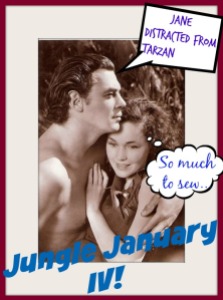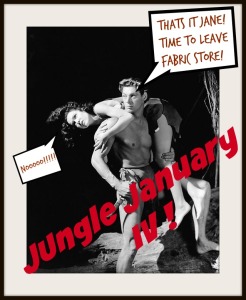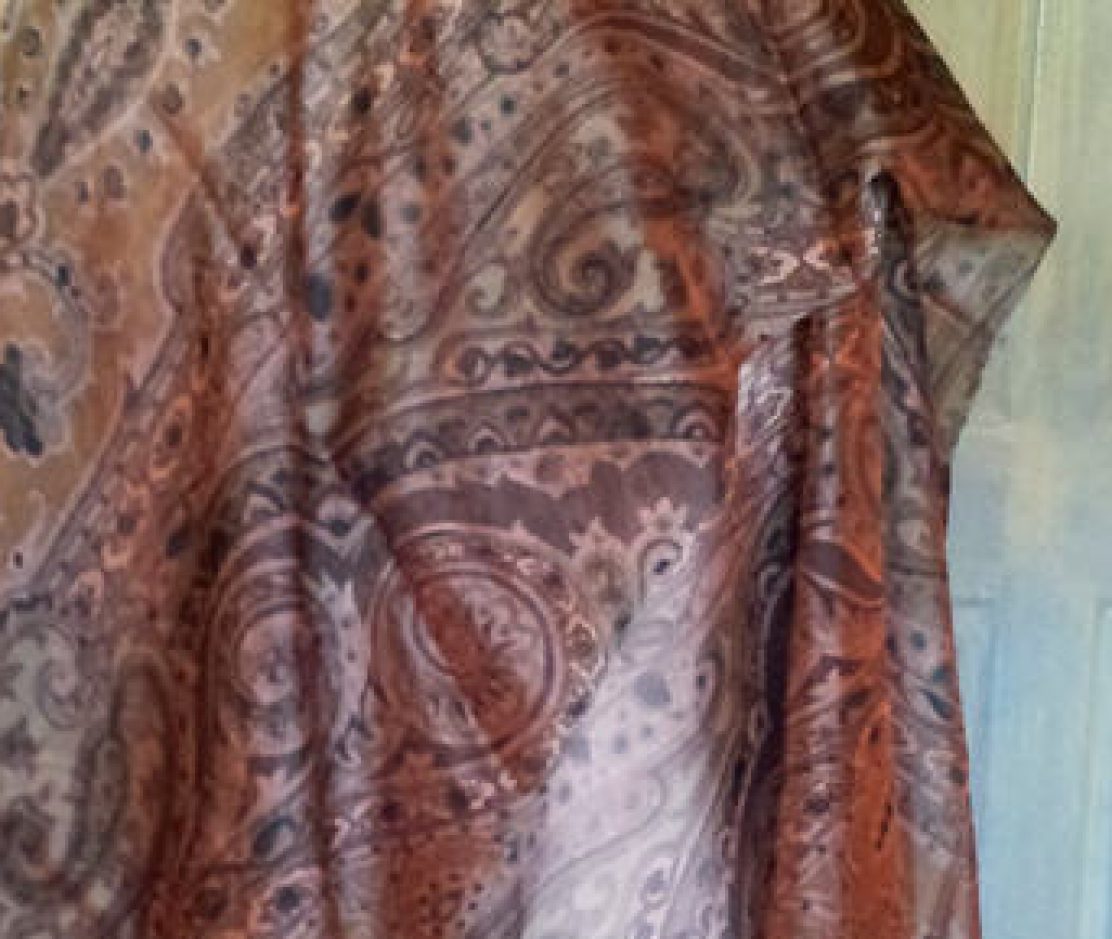
I really should be sewing right now. A two-part shimmering black snake is hissing at me from the cutting table.
Productivity here still hasn’t recovered from Plutonian shake-ups of last year. But I want to make sure the one beast I did manage to hack together doesn’t miss the Jungle January 2016 Party.
 As I’m still grieving for Mom, this year’s Jungle January pets (and maybe others) will all be refashioning items from her closet. First up is this psychedelic purple top which is now a skirt & a sash scarf/belt. I can’t tell whether this is a Zebra or Tiger stripe. So Tigra-Zeber it is then. Or should that be Tiber-Zegra instead? Anyway, don’t Google “zebra tiger” – the first image that comes up is seriously disturbing!
As I’m still grieving for Mom, this year’s Jungle January pets (and maybe others) will all be refashioning items from her closet. First up is this psychedelic purple top which is now a skirt & a sash scarf/belt. I can’t tell whether this is a Zebra or Tiger stripe. So Tigra-Zeber it is then. Or should that be Tiber-Zegra instead? Anyway, don’t Google “zebra tiger” – the first image that comes up is seriously disturbing!
Style Shots & Mug Shots
WORN WITH: Zara blouse.
WORN WITH: self-draped altered RTW top.
WORN WITH: Vogue Donna Karan 1282 top + RTW cardie from Mom.
Fabric & Notions Used
- Mystery flocked knit top from Mom’s Closet. I can’t find any photo of her in this, but I vaguely recall it’s a top + skirt combo. She must had this for ages, as the top had all the vertical darts let out presumably to accommodate the middle-age spread. Sadly the skirt’s gone. Sadder still because it means less fabric for me to play with.
- Lining: Skin color lightweight Power Mesh from Tissu Fabrics. These Power Mesh seem to have become my GoTo lining for knits.
- Invisible zipper, hook & eye from the Stash.
The Design & Pattern
What design? What pattern! While I wasn’t as wantonly destructive as the contestants of The Great British Sewing Bee in my refashioning, nonetheless as there was preciously little fabric left for proper pattern-drafting, I too had to improvise as I went along. Key seams were all unpicked. I needed every millimeter I could get.
Changes Made
- SKIRT
- Swapped front & back. My waist shaping always nudges the back waist on skirts downward rather than stay level at the waist. So the lower front neckline of the top was better suited for my back bottom. Especially as it already comes with bum (formerly bust) shaping. Granted the darts are from the side seams. In a plain fabric I would hesitate to use such shaping for the bum – what can I say, sometimes I give in to herd mentality too. So thank god this busy print hurry your eyes away from the darts to whichever ways.
- Widened & re-shaped neckline for waist.
- Re-shaped side seams & hem for A-line skirt shaping as this wastes the least amount of fabric.
- Added side invisible zipper & hook/eye at the top.
- Added lining (using main fabric as pattern) & reused neck facing for waist facing.
- SASH SCARF/BELT
- Spliced each sleeves length-wise into 4 strips & joined the short ends to create 2 long pieces for double-layered sash. The sleeve caps became the shaped ends of the sash.
The Verdict
Yeah, I could have just left this purple psychedelic top as a top. But then I wouldn’t be able to sent her to the Jungle January Party.
You see, while documenting the top as is, I decided my Mom’s top deserved better than a mug shot. So I found some leopardy playmates for her…

I know, it’s crazy busy & not everyone’s cup of tea. I usually don’t wear so much busy prints in one go. I was trying to honour of our gracious hostess by going all out. But actually I secretly LOVE this combination. Something vaguely Italian about it.
The scarf is Mom’s too. I decided against refashioning it. Firstly there’s not enough of it. Secondly some memories should be kept as is, especially as it play nicely with others & fit perfectly into my Look Book anyway.
The skirt is another altered RTW from 2012 & it’s the best shade of leopard that’s not high on something or other. The golden yellow is the perfect match for the psychedelic purple Tigra-Zeber-Tiber-Zegra. ‘Complementary colors’ they call it right? Most yellow leopards are such dull beasts. Not this skirt.
But now that TZTZ is also a skirt they won’t play nicely together anymore. So the hunt is on. Oh, did I just find an excuse to expand my stash? Oops.

















































































